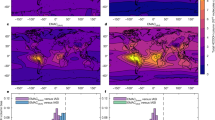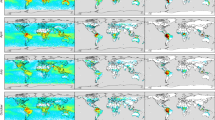Abstract
IN a recent communication1 Götz, Dobson and Meetham have reported that the average height of ozone in the atmosphere at Arosa, Switzerland, is about 20 km. This height is much less than the former estimates. Götz and Ladenburg2 and Buisson3 are in agreement with this view. Even at a height of 2–3 km. a perceptible amount of ozone may be present, but the highest concentration seems to be at a height of 15–50 km.
This is a preview of subscription content, access via your institution
Access options
Subscribe to this journal
Receive 51 print issues and online access
$199.00 per year
only $3.90 per issue
Buy this article
- Purchase on Springer Link
- Instant access to full article PDF
Prices may be subject to local taxes which are calculated during checkout
Similar content being viewed by others
References
NATURE, 132, 281, Aug. 19, 1933.
Naturwiss., 19, 373; 1931.
Rev. Optique, 12; 1933.
Trans. Faraday Soc., 27, 375, 393; 1931.
Sitz. Akad. Wiss., 216, 1912; 644, 1913; 872, 1914.
C.R. Acad. Sci., 156, 782; 1913.
Z. Phys., 49, 744; 1928.
Trans. Faraday Soc., 27, 378; 1931.
ibid., 27, 404; 1931.
Author information
Authors and Affiliations
Rights and permissions
About this article
Cite this article
DHAR, N., RAM, A. Formaldehyde in the Upper Atmosphere. Nature 132, 819–820 (1933). https://doi.org/10.1038/132819b0
Issue Date:
DOI: https://doi.org/10.1038/132819b0
This article is cited by
-
Bemerkungen zur Photochemie der Erdatmosphäre
Die Naturwissenschaften (1938)
-
Catalysed Reaction of Hydrogen with Water and the Nature of Over-voltage
Nature (1933)
Comments
By submitting a comment you agree to abide by our Terms and Community Guidelines. If you find something abusive or that does not comply with our terms or guidelines please flag it as inappropriate.



